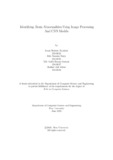| dc.contributor.advisor | Islam, Md. Saiful | |
| dc.contributor.author | Talukder, Ismat Shehrin | |
| dc.contributor.author | Ninty, Rifa Tasmim | |
| dc.contributor.author | Saimon, Md. Galib Hamza | |
| dc.contributor.author | Akbar, Shafkat Asif | |
| dc.date.accessioned | 2021-10-03T06:34:39Z | |
| dc.date.available | 2021-10-03T06:34:39Z | |
| dc.date.copyright | 2021 | |
| dc.date.issued | 2021-06 | |
| dc.identifier.other | ID: 21141025 | |
| dc.identifier.other | ID: 21141026 | |
| dc.identifier.other | ID: 21141027 | |
| dc.identifier.other | ID: 21141028 | |
| dc.identifier.uri | http://hdl.handle.net/10361/15104 | |
| dc.description | Cataloged from PDF version of thesis. | |
| dc.description | Includes bibliographical references (pages 33-38). | |
| dc.description | This thesis is submitted in partial fulfillment of the requirements for the degree of Bachelor of Science in Computer Science and Engineering, 2021. | en_US |
| dc.description.abstract | In a developing country like Bangladesh, it is tough to detect a brain abnormality, i.e., Pituitary tumor, Glioma, Meningioma, etc., in an early stage and treat them accordingly. In our proposed system, ML(Machine Learning) techniques under supervised learning will allow us to predict the early detection of brain diseases. We will approach by using image processing to separate the abnormal lesions from the normal ones ideally. We’ll also use CNN (Convolutional Neural Network) to stratify different brain abnormalities. Especially when it comes to early detection of brain abnormalities, we’ll also create image classifiers for stratification without human help by integrating genomic data to give them a better chance of survival through implementing a machine learning approach. This system is focused on any abnormality related to brain activity and helping the victims to recognize it. We have used 3 CNN models: ResNet50, VGG16, Inception V3, and then obtained satisfactory results. Then we also used the augmentation process in the ResNet50, VGG16, and Inception V3 models. Therefore, we got the best accuracy result in the ResNet50 model after augmentation. Our goal is to provide the proposal to the people of Bangladesh a revolutionary system that will give a plan best suited for every individual and increase the chances of survival for neurology patients to a beyond level. | en_US |
| dc.description.statementofresponsibility | Ismat Shehrin Talukder | |
| dc.description.statementofresponsibility | Rifa Tasmim Ninty | |
| dc.description.statementofresponsibility | Md. Galib Hamza Saimon | |
| dc.description.statementofresponsibility | Shafkat Asif Akbar | |
| dc.format.extent | 38 Pages | |
| dc.language.iso | en_US | en_US |
| dc.publisher | Brac University | en_US |
| dc.subject | Brain abnormality | en_US |
| dc.subject | Supervised learning | en_US |
| dc.subject | CNN | en_US |
| dc.subject | ML | en_US |
| dc.subject | Revolutionary system | en_US |
| dc.subject | Neurology | en_US |
| dc.subject | ResNet50 | en_US |
| dc.subject | VGG16 | en_US |
| dc.subject | Inception V3 | en_US |
| dc.subject | Augmentation | en_US |
| dc.title | Identifying brain abnormalities using image processing and CNN models | en_US |
| dc.type | Thesis | en_US |
| dc.contributor.department | Department of Computer Science and Engineering, Brac University | |
| dc.description.degree | B. Computer Science | |

